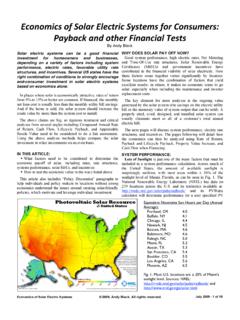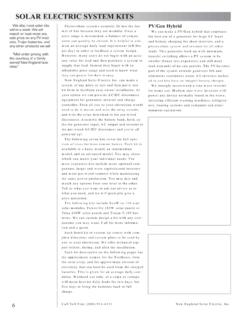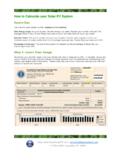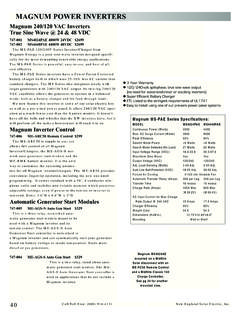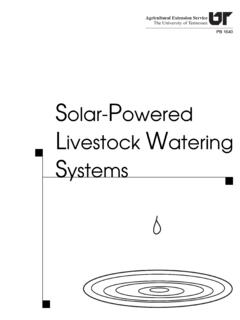Transcription of SOLAR PV SYSTEM MAINTENANCE GUIDE - …
1 SOLAR PV SYSTEM . MAINTENANCE GUIDE . GUYANA HINTERLANDS STAND-ALONE SOLAR PV. INSTALLATIONS. IMPROVING HEALTH FACILITY INFRASTRUCTURE (IHFI) GUYANA. CONTRACT NO. EPP-I-00-03-00008-00, TASK ORDER 07. APRIL 2013. This publication was produced for review by the United States Agency for International Development. It was prepared by Tetra Tech Inc. i Contents Introduction .. 1. 2. Battery MAINTENANCE .. 2. 1. Battery Inspection and 2. 2. Checking the Electrolyte 4. 3. Checking Battery 6. Battery Alerts .. 6. SOLAR Panel MAINTENANCE .. 7. Inverter/Battery Charger and Charge controller .. 7. Wiring and Connections .. 8. SOLAR SYSTEM MAINTENANCE Schedule .. 9. Panel MAINTENANCE Log Sheet (every 3 months).
2 10. Weekly Battery Inspection Log Sheet for "Deep Cycle Flooded" Lead acid Battery .. 11. Weekly Battery Inspection Log Sheet for AGM and GEL 12. i Introduction The Improving Health Facility Infrastructure (IHFI) project, funded by USAID, works to improve the access to and reliability of energy while reducing costs in health facilities in countries around the world. In Guyana, IHFI has focused, in part, on SOLAR PV electrification of rural health centers and clinics. In this context the IHFI Guyana energy team conducted sites assessments of several hinterland health centers/outposts to design and implement energy solutions to improve delivery of health services.
3 This manual outlines certain preventive MAINTENANCE elements of small stand-alone SOLAR PV. systems. It explains routine MAINTENANCE tasks involved in the care of batteries, SOLAR panels, wiring and loads for stand-alone PV systems. The picture below shows the components of a typical stand- alone SYSTEM . SOLAR PV SYSTEM MAINTENANCE GUIDE 1. MAINTENANCE Proper MAINTENANCE ensures that SOLAR SYSTEM life is preserved for as long as possible and the original conditions of the SYSTEM are sustained, while compensating for normal wear and tear. SOLAR systems require little MAINTENANCE as compared to other electric systems such as diesel generators; however, they are not MAINTENANCE free.
4 This document provides instructions on performing preventative MAINTENANCE on major components of a SOLAR PV SYSTEM : 1. Battery 2. SOLAR Panels 3. Charge Controller 4. Inverter 5. Wiring and connections Battery MAINTENANCE A battery is a device which is used to store electrical charge. The pictures below show two common types of batteries used in SOLAR installations. Sealed Gel Battery Deep Cycle Flooded -Lead Acid Battery Batteries should be regularly and carefully maintained to extend their useful life. These activities include: 1. Inspecting and cleaning regularly 2. Checking the electrolyte level (not required for Gel Batteries). 3. Keeping in a high state of charge 1.
5 Battery Inspection and Cleaning A visual inspection should be done to assess the general condition of the SYSTEM 's batteries. Check for any electrolyte leak, cracks in the batteries, or corrosion at the terminals or connectors. SOLAR PV SYSTEM MAINTENANCE GUIDE 2. Effects of poor MAINTENANCE techniques are shown in the pictures below. Batteries should be clean, dry and free of electrolyte and corrosion residue. Corrosion at battery terminals is seen as a white coating around the battery terminals. Cleaning should be done once monthly. Precautions To minimize hazards, the following precautions should be taken prior to carrying out battery MAINTENANCE . Safety goggles must be worn when performing battery MAINTENANCE Protective gloves and chemical-resistant rubber gloves must be worn to prevent contact with battery acid.
6 If there is acid spillage, neutralize the acid with a water and bi-carbonate soda solution. Metal files should not be used to remove corrosion. Use tools with insulated handles to carry out any MAINTENANCE . Do not smoke or light fire near batteries. Batteries produce hydrogen gas which is highly flammable. SOLAR PV SYSTEM MAINTENANCE GUIDE 3. Before MAINTENANCE is carried out, each component of the SYSTEM should be isolated. This would involve switching off circuit breakers to and from the battery bank and the SOLAR panels. Battery cleaning procedures are as follows: 1. Switch off/disconnect all loads on the SYSTEM . Turn off or disconnect the SOLAR charge. Then turn off the circuit breaker to and from the battery bank.
7 2. Ensure that the caps on the batteries are sealed tight to keep any dirt from entering the battery. Wipe the top and outside of the battery with a (damp) cloth. If corrosion is present at the terminals, mix baking soda with fresh water and apply the solution to the affected area. Stubborn areas should be scrubbed with a metal brush. After cleaning, rinse the terminals with water. If available, apply petroleum jelly or grease to the connected terminal to prevent future corrosion. 3. MAINTENANCE of gel cell and AGM batteries relates only to the battery terminals and connections. The terminals and posts should be wiped until they are shiny, and if corroded, clean them properly with Bi-carbonate soda and water.
8 If available, apply petroleum jelly or grease to the connected terminals. 2. Checking the Electrolyte level Battery MAINTENANCE involves checking the cell electrolyte level for correct acid volume once a month. The cells should be watered back to the original acid level which is - " below the bottom of the vent well (the tube inside the battery cell with slots on each side). Use only distilled water to top up the batteries. Testing for the specific gravity of electrolyte in the battery is an accurate way to measure and compare the state of charge of each individual cell. The process of checking the electrolyte specific gravity for a "Deep Cycle Flooded" Lead Acid battery is given below: SOLAR PV SYSTEM MAINTENANCE GUIDE 4.
9 1. First, remove the caps from each cell one at a time. Carefully insert the hydrometer into the cell. 2. Draw liquid into the hydrometer and avoid bumping the hydrometer. The float should not be flooded or sticking to the sides of the glass tube. 3. Obtain a reading by looking at the float which corresponds to a level on the tube. The acid level in the batteries should be within two centimeters of the top of the battery. A visual inspection could also be made to check the condition of the plates. Record the cell number and the results. 4. Do not replace liquid from one cell to another. The table below shows typical battery state-of-charge at various levels of specific gravity.
10 The voltages mentioned below are for 12V and 6V batteries. Note that the table above gives only indicative values; specific gravity will vary somewhat depending on the battery type and brand, and on the battery's temperature. The specific gravity readings of each cell should be recorded and maintained in a log sheet. SOLAR PV SYSTEM MAINTENANCE GUIDE 5. 3. Checking Battery Voltage Another important measure in determining the battery state of charge is the battery voltage. A volt meter is used to measure this quantity. The positive lead of the volt meter should be connected to the battery's positive terminal and the negative lead of the volt meter should be connected to the negative terminal of the battery.

